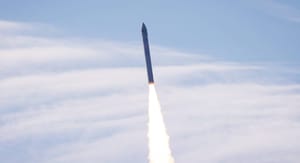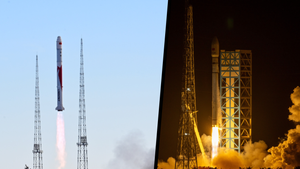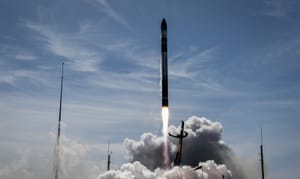
SpaceX successfully launched its fourth flight test of Starship-Super Heavy, its in-development fully reusable super-heavy lift rocket, from Boca Chica in Texas at 12:50 pm Universal Coordinated Time, or 07:50 am Central Time.
Slow motion liftoff of Starship on Flight 4 pic.twitter.com/9itFbrfxW7
— SpaceX (@SpaceX) June 6, 2024
Ship 29 and Booster 11 lifting off in slow motion via SpaceX on X.
Super Heavy Booster 11 successfully lit all thirty-three Raptor engines lifting the rocket off of the pad, one engine did shutdown early at T+4 seconds. The remaining thirty-two engines did successfully continuously fire up until 'most engines cut-0ff', where all but three engines are shut off.
At T+2:52 Ship 29 lit all six of its Raptor engines, three sea-level and three vacuum, and 'hot-staged' off of Booster 11. Six seconds later Booster 11 relit ten engines and began its boost backburn, which uses thirteen of its engines.
Starship’s Raptor engines have ignited during hot-staging separation. Super Heavy is executing the flip maneuver and boostback burn pic.twitter.com/TsdIKpqLJH
— SpaceX (@SpaceX) June 6, 2024
Ship 29 hot-staging from Booster 11 via SpaceX on X.
Booster 11 ended its boost backburn at T+3:56 with no early engine shutdowns. At T+4:10 visual confirmation of successful hot-staging ring jettisonning was observed, the ring was detached to save some excess mass for landing.
Hot stage jettison pic.twitter.com/J48QtQD1Ae
— SpaceX (@SpaceX) June 6, 2024
Booster 11's hot-staging ring being jettisoned via SpaceX on X.
Super Heavy Booster 11 passed through its descent toward the Gulf of Mexico with no issues called out. The landing burn began at T+7:08 with twelve out of the required thirteen engines starting. Despite having one engine out, Booster 11 successfully splashed down in the Gulf of Mexico at T+7:30 at a speed of ten kilometers per hour, or six miles per hour.
Super Heavy has splashed down in the Gulf of Mexico pic.twitter.com/hIY3Gkq57k
— SpaceX (@SpaceX) June 6, 2024
Booster 11's landing and splashdown in the Gulf of Mexico via SpaceX on X.
Ship 29 shut down its three Raptor Vacuum engines at T+8:09, with its three sea-level Raptors doing the same at T+8:37. Minor uncontrolled rolls were thought to be observed not long after engine cutoff but by atmospheric entry the Ship had control over its attitude.
Starship coasting in space pic.twitter.com/kphbuXuEMr
— SpaceX (@SpaceX) June 6, 2024
Ship 29 coasting in space during flight four via SpaceX on X.
Atmospheric entry of Ship 29 began at T+45:24 when plasma was seen beginning to build on the heatshield side of the Ship, the plasma is caused by the atmosphere not being able to move out of the way fast enough leading to superheating. Flight controllers called out that Ship 29 had control of its entry orientation via its flaps and attitude control system not long after the start of entry.
Peaking heating. Starship on a good entry trajectory pic.twitter.com/H0Gv6hyvt2
— SpaceX (@SpaceX) June 6, 2024
Ship 29 during atmospheric entry via SpaceX on X.
Ship 29 successfully passed through peak heating on entry, proving that the thermal protection tiles can withstand the heat. At T+57:12 however a burn-through was seen beginning on the starboard forward flap of Ship 29, this burn-through would intensify through entry until at least one of its actuators also disintegrated. Based on similar debris seen flying past the camera, the port forward flap may have also experienced a similar burn-through.
Despite the burn-throughs, at T+1:01:46 flight controllers called out that Ship 29 had passed through maximum dynamic pressure on descent, which is where the most stress is experienced by the vehicle. By T+1:03:48 Ship 29 had passed through the supersonic portion of descent successfully.
Nearing the end of its flight, Ship 29 achieved its terminal velocity of 368 kilometers per hour, or 228 miles per hour, at T+1:05:29. Not long after at T+1:05:38 Ship 29 began its 'flip-and-burn' maneuver leading to a successful splashdown in the Indian Ocean at T+1:05:57.
How does it compare to flight three?
During flight three, Ship 28 and Booster 10 completed a nominal ascent with all thirty-three raptors running successfully on Super Heavy, and Starship successfully lighting all six engines and hot-staging as expected.

The first problem in flight three was during the Boosters 'boost back' burn where all thirteen engines needed relit successfully before six engines shut down early. These six engines shutting down early led to a shorter 'boost back' burn but did not prevent a landing burn attempt. The landing burn was then attempted but with the six engines disabled leading to only seven being commanded to start, only two successfully started with one appearing to burn off nominally. SpaceX believes the most likely root cause of this issue was a continuous filter blockage for liquid oxygen to the engines, which led to a loss of inlet pressure in the oxygen turbopumps. Observers combing through footage from the last flight also believe the hot-staging ring was ripped off by aerodynamic forces, which may have led to the erratic grid fin movement seen before its destruction.
The other major issue faced during the last flight test was a loss of attitude control of the Ship after it began its in-space coast phase. This led to the Ship rolling along all three axes. The lack of control also had the ship reenter Earth's atmosphere off nominally and heating both the protected and unprotected sides of the vehicle. SpaceX believes the cause of this issue was clogging of the valves responsible for roll control in-space.
Unlike the second flight, flight three made it to Ship re-entry and past the majority of the booster's descent.
What changes were on Ship 29 & Booster 11?
All information in this section was spotted and gathered by the teams of the Ringwatchers and a more in-depth list can be found here.
Ship 29
Ship 29 is largely a twin of Ship 28, which flew on flight three, and had very few changes compared to its twin, but a few differences are present. One of the less obvious changes is additional attitude control system thrusters, specifically for additional roll control. A slightly more obvious change is that a horizontal seam is now not present as SpaceX seeks to simplify the heatshield, a new glue is also believed to be used on certain parts of Ship 29 to prevent tile loss.
Booster 11
Booster 11 had quite a few publically known changes, as SpaceX rarely offers views inside vehicles. The first change is the shortening of the engine chill pipe which now stops just above the grid fins, the pipe helps divert gasses from Ship 29's six Raptor engines. Booster 11's liquid methane tank had been massively reinforced as it now features seventy-four internal stringers, compared to twenty-four on previous boosters. The four 'cowbell' deflectors on Booster 11 had also been reinforced, these diverters redirect vented gasses.
What is Starship-Super Heavy?
Starship-Super Heavy is SpaceX's in-development fully reusable super heavy-lift launch vehicle and the largest rocket currently flying. SpaceX is currently aiming to have the launch vehicle deliver one-hundred and fifty tons to low Earth orbit while reused or two-hundred and fifty tons when expended, although there are rumors from SpaceX of an expendable payload capacity of three-hundred tons.
On the launch pad, Starship-Super Heavy is one-hundred and twenty-one meters tall and weighs 5,000,000 kilograms fully fuelled. The diameter of both vehicles is nine meters, excluding aerodynamic control surfaces.
What is Starship?

Starship is the second-stage of the Starship-Super Heavy launch vehicle and is planned to be capable of multiple missions into orbit, after a short refurbishment. The vehicle is fifty meters tall and nine meters in diameter, excluding its four aerodynamic control surfaces. Fully fuelled Starship is believed to weigh 1,300,000 kilograms with an approximate weight of 100,000 kilograms unfuelled.
The Starship second-stage is powered by three sea-level Raptor engines along with three vacuum-optimized Raptor engines. These sea-level engines are believed to generate 230 tons of thrust each with the vacuum-optimized engines generating 258 tons of thrust each for a total combined 1,500 tons of thrust for Starship. The vacuum-optimized Raptors are unable to gimbal requiring the sea-level Raptors for control of the second-stage on ascent and landing.
The total burn time for the Starship second-stage remains unknown outside of SpaceX but is known to burn liquid methane and liquid oxygen in its engines.
In order to survive re-entry for reuse, Starship has several thousand thermal protection tiles on one side of the vehicle and on all four of its aerodynamic control surfaces. The four control surfaces help guide the vehicle during re-entry and prior to landing inside the atmosphere at a pre-determined location. Starship also has a series of small thrusters to control the vehicle in space before re-entry.
SpaceX is believed to be working on a few variants of Starship for use as a Moon lander, tanker, space station, Mars lander, and as a crewed spacecraft.
What is Super Heavy?

Super Heavy, also called 'the Super Heavy booster', is the first-stage of SpaceX's Starship-Super Heavy launch vehicle. The giant Super Heavy first-stage is planned to be capable of multiple flights per day with minimal refurbishments and inspections. The vehicle is seventy-one meters tall and nine meters in diameter, excluding its four grid fins and chines. Fully fuelled Super Heavy is believed to weigh 3,600,000 kilograms with an approximate mass of 200,000 kilograms unfuelled.
The Super Heavy first-stage is powered by thirty-three sea-level Raptor engines generating a combined thrust of 7,590 tons, with each engine generating 230 tons of thrust. The outer twenty Raptor engines are unable to gimbal with the inner thirteen being able to for control of the first-stage.
The total burn time of Super Heavy remains unknown outside of SpaceX but is known to burn liquid methane and liquid oxygen in its engines.
To enable the reuse of Super Heavy, the vehicle has four large grid fins placed in the interstage to assist in guiding and controlling during descent. Super Heavy also has four chines running along the lower third of it to generate lift and assist in stabilization.
Shortly after completing the ascent, Super Heavy relights ten engines, as three were running during staging, and performs a 'boost back' burn in order to return to the launch site. After the 'boost back' burn is completed the engines shut down with Super Heavy being guided by a series of small thrusters and its grid fins. Once Super Heavy is at the correct altitude above is landing location three engines start backup for the landing burn. SpaceX currently plans to have Super Heavy land in the ocean with launch site landing attempts happening with later flights.
Super Heavy also features a hot-staging ring atop of it to allow for a faster and simpler staging process, according to SpaceX. The hot-staging ring has dozens of gaps on the sides to allow for the Raptor engine exhaust of Starship to escape.



